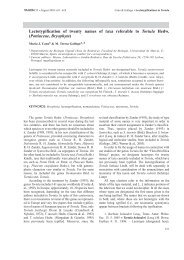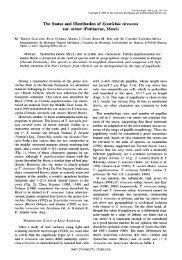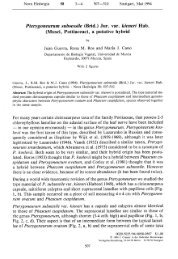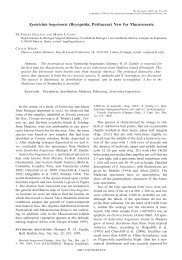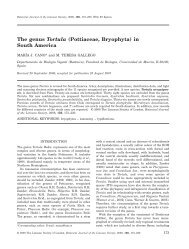Bryological Monograph An annotated checklist of the mosses of ...
Bryological Monograph An annotated checklist of the mosses of ...
Bryological Monograph An annotated checklist of the mosses of ...
Create successful ePaper yourself
Turn your PDF publications into a flip-book with our unique Google optimized e-Paper software.
MOSSES OF EUROPE AND MACARONESIA 201Table 3.Non-native <strong>mosses</strong> in Europe.SpeciesAchrophyllum dentatumAtrichum crispumBryum apiculatumBryum valparaisenseCalomnion complanatumCalyptrochaeta apiculataCampylopus intr<strong>of</strong>lexusHennediella macrophyllaHennediella stanfordensisHypopterygium tamarisciLeptophascum leptophyllumLepto<strong>the</strong>ca gaudichaudiiMyuroclada maximowicziiOrthodontium lineareSematophyllum adnatumSplachnobryum obtusumSyntrichia bogotensisTortula amplexaTortula bogosicaTortula bolanderiThuidiopsis sparsaLocationGarden, EnglandBritain and Ireland, widespread (male only)TenerifeCanary Islands, PortugalGarden, IrelandBritain, rareC. and W. Europe, widespreadBritain, widespread and spreadingBritain and Ireland, widespread and spreadingPortugalWidespread in S. and W. Europe, apparently spreadingGarden, IrelandGarden, sou<strong>the</strong>rn RussiaC. and W. Europe, widespreadLombardy and Piedmont, several localitiesHot springs, Hungary and Azores; elsewhere in greenhousesMadeiraBritain, confined to one small areaAzores and CanariesS. Europe (rare), MacaronesiaMadeira, in a former park areacombinations are given in <strong>the</strong> second edition <strong>of</strong> his flora(Smith, 2004).Heterocladium flaccidum (Schimp.) A.J.E.Sm., stat. etcomb. nov. Basionym: Heterocladium heteropterum var.flaccidum Schimp. in Bruch, Schimp. & W.Gümbel,Bryologia Europaea 5: 154 (fasc. 49–51). 1852.Hypnum cupressiforme var. heseleri (<strong>An</strong>do & Higuchi)M.O.Hill, stat. et comb. nov. Basionym: Hypnum heseleri<strong>An</strong>do & Higuchi, Journal <strong>of</strong> <strong>the</strong> Hattori BotanicalLaboratory 75: 98. f. 1–2. 1994.Pelekium atlanticum (Hedenäs) Hedenäs, comb. nov.Basionym: Thuidium atlanticum Hedenäs, Journal <strong>of</strong>Bryology 16: 387. f. 1–2. 1991.Pohlia flexuosa var. pseudomuyldermansii (Arts,Nordhorn-Richter & A.J.E.Sm.) A.J.E.Sm., comb. nov.Basionym: Pohlia muyldermansii var. pseudomuyldermansiiArts, Nordhorn-Richter & A.J.E.Sm. Journal <strong>of</strong> Bryology14: 642. f. 3. 1987.Weissia6mittenii (Bruch & Schimp.) Mitt. emend.A.J.E.Sm., stat. nov. Basionym: Weissia mittenii (Bruch &Schimp.) Mitt., <strong>An</strong>nals and Magazine <strong>of</strong> Natural History,ser. 2, 8: 317. 1851.Planta originis hybridae. Parens feminea Weissia multicapsularis.Parens mas forte W. rostellata.Composition <strong>of</strong> <strong>the</strong> moss floraThe moss flora comprises 1292 species in 278 genera, 71families and 22 orders. In addition, we recognize 46subspecies and 118 varieties. Of <strong>the</strong> total 1292 species, 53are confined in Europe to <strong>the</strong> Atlantic islands <strong>of</strong>Macaronesia (Table 2). In addition, Bryoxiphium norvegicum,Didymodon brachyphyllus and Polytrichastrumsphaero<strong>the</strong>cium are confined to Iceland, and Bryumminiatum to <strong>the</strong> Faeroe islands.In <strong>the</strong> east and south-east, several species are known onlyfrom Russia, mainly from <strong>the</strong> Urals and <strong>the</strong> Caucasus. InAsia just outside Europe, Crumia latifolia, Tortula caucasicaand Trichostomum connivens are known from <strong>the</strong>Caucasus. <strong>An</strong> additional eight species are listed byKürschner & Erdağ (2005) from <strong>An</strong>atolia.Twenty-onespecies<strong>of</strong>mossarethoughttohavebeenintroduced to Europe by human agency (Table 3), aremarkably small number. Mosses must have beenintroduced from <strong>the</strong> Americas, especially to Macaronesia,before moss recording began; but invasions before1900 would not have been noticed. No non-native speciesis known to have arrived before 1800, though Corley &Frahm (1982) have speculated that Campylopus pyriformisis a late 18th century introduction from <strong>the</strong> Sou<strong>the</strong>rnHemisphere. Indeed, <strong>the</strong> only alien known to have reachedEurope before 1900 is <strong>the</strong> North American Atrichumcrispum, which has spread slowly and is probably a singleclone. There are several o<strong>the</strong>r species that may beintroduced. For example Bryum gemmiferum, now widespreadin central and west Europe, appears still to bespreading, and lacks pre-1940 records (HermanStieperaere, pers. comm.).TAXONOMIC HIERARCHYThe main source for <strong>the</strong> hierarchy is G<strong>of</strong>finet & Buck(2004). A few genera have been moved between families totake account <strong>of</strong> suggestions from Ignatov and Hedenäs orwhere <strong>the</strong>re is evidence from newer molecular phylogenies.The following classes and orders occur in Europe. Ordersare included in <strong>the</strong> list <strong>of</strong> taxa, below.




